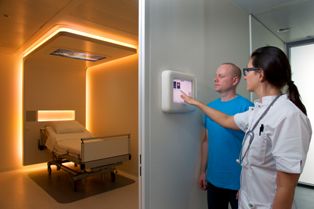Philips opens centre for study of healing environments
1 November 2011
Philips has opened a dedicated research facility for studying healing environments at its Eindhoven-based Research Laboratories.
The aim of a healing environment is to accelerate and improve treatment outcomes, while simultaneously reducing the stress and anxiety associated with hospitalisation and hospital-based treatment.
The company has long studied the patient's hospital experience and has conducted extensive studies of patient experience flows in real hospital environments to feed back to the design of healing environments.
Philips is in an almost unique position of having both a consumer products arm and a healthcare arm that can cross fertilise ideas. This enables it to combine expertise in areas such as lighting and sound with healthcare.
“There is an increasing body of evidence to suggest that patient-friendly comforting environments not only reduce anxiety levels but also promote the healing process itself,” said Henk van Houten, general manager Philips Research.
“The opening of the Hospital Area is a clear expression of our commitment to this important new area of healthcare research, which leverages Philips' unique expertise in healthcare, lighting and consumer lifestyle. It is further evidence of Philips’ aim to deliver meaningful innovations that improve people’s lives.”
One of the concepts that is being studied uses soothing lighting and calming video images and sounds, and is aimed at reducing the stress levels of patients in various medical situations.
One treatment scenario is for patients who are in the preparation room awaiting a PET-CT scan for cancer diagnosis. The preparation room has been identified as one of the most stressful environments for cancer patients. The use of a specially designed room to control light, images and sound is being studied as a means of improving the experience for the patient while preparing for the scan.

The patient can choose the ambient experience
in the preparation room,
including sounds and images
displayed on the ceiling
Patients who have suffered from stroke are very sensitive to sound and light in the early recovery phase then later need more stimuli. So Philips has designed a patient room that adapts to the clinical and psychological state of the stroke patient to provide the optimum sensory experience to aid recovery. Another project that is well advanced is the the prevention of delirium in intensive care units. A hospital environment cockpit allows hospital staff to monitor patients for signs of delirium and monitor the level of noise that the patient experiences.
As people’s access to information increases and they become more knowledgeable about their medical conditions and therapy options, they demand greater choice in where and how they are treated. As a result, hospitals have to become increasingly people-focused to satisfy those demands. Offering an environment and an experience that helps patients cope with a difficult period in their lives is one way in which hospitals can achieve that objective.
Philips' pioneering Ambient Experience, incorporates ambient healing in medical imaging rooms and emergency departments. Architecture, design and technology (eg lighting, sound and projection) have been integrated to create a healthcare space that is designed to reduce the anxiety and increase the comfort of children that are being scanned, while improving the hospital workflow.
Moving further in this new field, Philips says it will research new healing environment solutions in the Hospital Area, in scenarios as close as possible to those that are encountered in real hospitals.